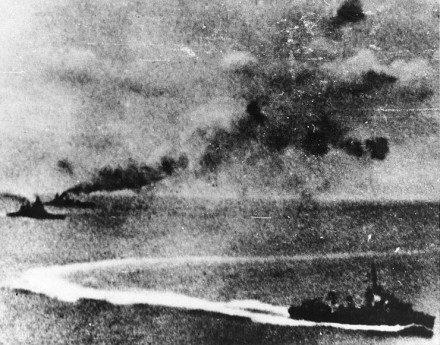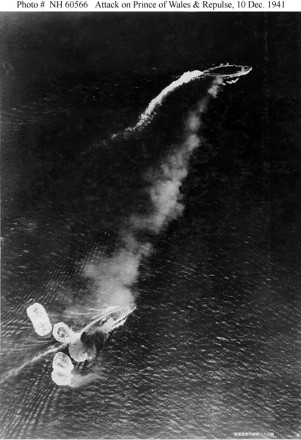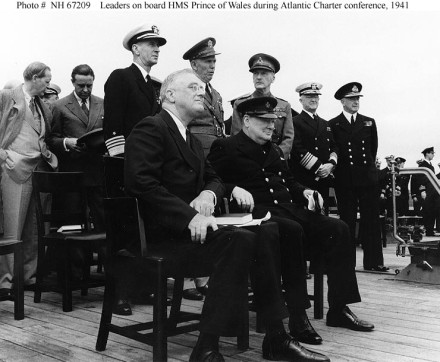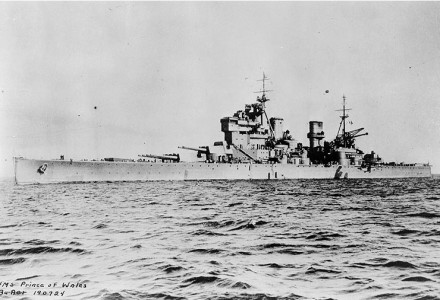History
Overview
The HMS Prince of Wales had a brief but active career in the Second World War. She was involved in several key actions of WWII, including the battle of Denmark Strait against the Bismarck, operations escorting convoys in the Mediterranean and carrying Churchill to the Atlantic Conference, as well as her final actions in Asia ending in her sinking in the South Chinese Sea in 1941.
This event - her sinking by Japanese land-based bombers - is one of the events that led to the end of the battleship being considered the predominant class in naval warfare.
She was commissioned just before WWII and escaped tragedy when the dock in which she was lying for the final fitting was bombed. In late May 1941, while still not fully operational, she was sent into action with the German battleship Bismarck and received significant damage from heavy gunfire.
Following repairs, the Prince of Wales carried Prime Minister Winston Churchill across the Atlantic to Newfoundland. There, between 9 and 12 August, Churchill joined U.S. President Franklin D. Roosevelt for the Atlantic Conference, the first meeting between the leaders of the two English-speaking nations of what was emerging as the "Grand Alliance" against the Axis powers.
Force Z
The Prince of Wales was sent to the Far East on 25th October 1941 with the battlecruiser HMS Repulse where she was to form 'Force Z' to counter the swiftly developing Japanese threat in the region. She docked in Singapore on 2 December.
Force Z was an allied naval detachment consisting of the Prince of Wales, Repulse and four destroyers (HMS Electra, Express, Encounter, and Jupiter). Two Dutch submarines (K-XIII and O-16) were deployed in the same area for support.
Sinking of the Prince of Wales
On 8 December Force Z was dispatched to investigate reports of Japanese landing forces at Kuantan in Malaysia. On arriving there they found the reports to be false. In the meantime Force Z had been spotted by a Japanese submarine.
At 11 o'clock in the morning on December 10th, Japanese bombers and torpedo aircraft began their assault on Force Z. In a second attack at 11:30, torpedoes struck the Prince of Wales on the port side, wrecking the outer propeller shaft and causing the ship to take on a heavy list.
A third torpedo attack developed against the Repulse but she managed to avoid all torpedoes aimed at her. A fourth attack by a torpedo-carrying Type 'Bettys' aircraft sank the Repulse at 12:33. Six aircraft from this wave attacked the Prince of Wales, with four of their torpedoes hitting the ship, causing major flooding of the ship. Finally a 500 kg bomb hit the catapult deck, penetrated through to the main deck and exploded, tearing a gash in the port side of the hull.
At 13:15 the order was given to abandon ship and at 13:20 the Prince of Wales sank, with Vice-Admiral Tom Phillips and Captain John Leach among the 327 fatalities. It is often pointed out that a contributing factor to the sinking of Prince of Wales was the fact that her surface scanning radar was not operating.

To the left HMS Repulse and Prince of Wales. Photograph by Underwood & Underwood.
Aftermath
The Prince of Wales and Repulse were the first large ships to be sunk solely by air power on the open sea (albeit by land-based rather than carrier-based aircraft), a harbinger of the diminishing role this class of ships was to play in naval warfare thereafter.

Loss of HMS Prince of Wales and Repulse, 10 December 1941: photograph taken from a Japanese aircraft during the initial high-level bombing attack.
Atlantic Charter
An important chapter in the life of this ship was the Atlantic Conference, which was held in Placentia Bay, Newfoundland from August 9 through August 12, 1941, to discuss Allied war strategy. It was a meeting between the United States and Great Britain. One significant point to note is that the United States had not entered the war yet, making this a meeting between a belligerent and non-belligerent nation. In the picture below, we see conference leaders during church services on the aft deck of the Prince of Wales. At this conference Roosevelt and Churchill developed a friendly relationship, this being the first time that they had met in person. The result of this conference was the Atlantic charter, which outlined Allied intentions for the postwar period.

Description
A King George V-class battleship of the British Royal Navy.
Yard: Cammell Laird shipyard in Birkenhead, England.
Laid down in 1937, completed on 31 March 1941.
Propulsion: 8 Admiralty 3-drum small-tube boilers

The HMS Prince of Wales photographed in 1941, sometime prior to her engagement on May 24th with the German battleship Bismarck. She is lowering a Supermarine Walrus amphibian aircraft over the side.
| Master | John Leach |
|---|---|
| People on board | 1,521 |
| Speed | 28 knots ~ 32 mph (52 km/h) |
| Length | 745 feet (227.1 m) |
| Width | 103 feet (31.4 m) |
| Draft | 28 ¾ feet (8.8 m) |
| Tonnage | 44500 ton |
| Displacement | 37300 ton |
Status
The wreck lies upside down in 223 feet (68 m) of water, near Kuantan, in the South China Sea. A British flag attached to a line on a buoy tied to a propeller shaft is periodically renewed. The wreck site was designated as a 'Protected Place' in 2001 under the Protection of Military Remains Act 1986, just prior to the 60th anniversary of her sinking.
The ship's bell was manually raised using closed-circuit mixed-gas rebreathers (necessary because of the great depth) in 2002 by British technical divers Gavin Haywood and George McClure with the permission of the Ministry of Defence and blessing of the Force Z Survivors Association. It was restored, then presented for permanent display by First Sea Lord and Chief of Naval Staff, Admiral Sir Alan West, to the Merseyside Maritime Museum in Liverpool. It is currently traditional for every passing Royal Navy ship to perform a remembrance service over the site of the wrecks.